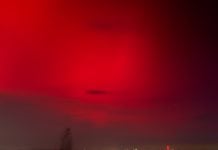A large coronal hole in the sun’s atmosphere is facing Earth and spewing solar wind in our direction.
NOAA forecasters say there is a 40% to 45% chance of G1-class geomagnetic storms when the solar wind stream arrives.

First contact with the stream caused an outburst of green auroras before daybreak in Alaska.
NOAA forecasters say there is a 40% to 45% chance of G1-class geomagnetic storms when the solar wind stream arrives.
So far, the gaseous material has not caused a full-fledged geomagnetic storm, but this could change in the hours ahead.
First contact with the gaseous material could take place during the late hours of Oct. 24th, certainly no later than Oct. 25th.
This coronal hole has been spinning around with the sun for more than 4 months, sending solar wind to Earth almost every 26 days.
It has previously sparked auroras in the USA as far south as Idaho, Maine, Michigan Montana, Wisconsin, and Wyoming.
Similar displays could occur this week if the coronal hole retains some of its old potency.
This map from NOAA shows where auroras could appear – most likely above the green line, corresponding to a planetary K-index of 5:

Many people think solar activity vanishes during Solar Minimum. Sunspot activity diminishes, however large holes form in the sun’s atmosphere during Solar Minimum because the sun’s magnetic field is weaker than normal.
Solar wind is constantly being ejected from these coronal holes and can ignite amazing nothern lights on Earth. Keep your eyes to the sky! [SpaceWeather]











